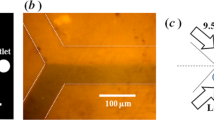Abstract
Ordered nanostructures of porin from the outer membrane of Yersinia pseudotuberculosis (YpOmpF) were formed in two ways: from proteoliposomes and by direct protein reconstitution in the pre-deposited phospholipid bilayer on mica surface. The morphological analysis of the structures was performed by atomic force microscopy. It was shown that the efficiency of formation, the degree of homogeneity, and the size of porin domains substantially depend on the experimental conditions and the presence of lipopolysaccharide in a porin sample or in the bilayer. It was found that using proteoliposomes resulted in formation of the aggregates of porin nanodomains on the mica surface, with uneven distribution in the bilayer and quite different size ranges (50–250 nm). In the case of direct reconstruction of porin, it was shown that a decrease in pH of the solubilizing buffer promotes the inclusion of a sufficiently large amount of protein as homogeneous domains with an average size of 35–40 nm but does not lead to the formation of extended nanostructured regions in the bilayer. The most efficient incorporation of porin into the lipid bilayer with the formation of clusters of tightly packed protein domains was achieved using a porin sample in combination with peptidoglycan and lipopolysaccharide, which this protein is tightly bound to in the native bacterial membrane.




Similar content being viewed by others
REFERENCES
H. Wang, T.-S. Chung, Y. W. Tong, et al., Small 8 (8), 1185 (2012).
M. Bieligmeyer, F. Artukovic, S. Nussberger, et al., Beilstein J. Nanotechnol. 7, 881 (2016).
N. V. Medvedeva, O. M. Ipatova, Yu. D. Ivanov, et al., Biomed. Khim. 52 (6), 529 (2006).
G. E. Schulz, Biochim. Biophys. Acta 1565 (2), 308 (2002).
A. Wiese, G. Schroder, K. Brandenburg, et al., Biochim. Biophys. Acta 1190 (2), 231 (1994).
D. J. Muller and A. Engel, Curr. Opin. Colloid Interface Sci. 13 (5), 338 (2008).
L. Hasler, J. B. Heymann, A. Engel, et al., J. Struct. Biol. 121, 162 (1998).
B. R. Glick and J. J. D. Pasternak, Molecular Biotechnology: Principles and Appliactions of Recombinant DNA, 2nd ed. (ASM Press, Washington, DC, 1998; (Mir, Moscow, 2002).
J. P. Rosenbusch, J. Biol. Chem. 249 (24), 8019 (1974).
T. I. Burtseva, L. I. Glebko, and Yu. S. Ovodov, Anal. Biochem. 64 (1), 1 (1975).
O. D. Novikova, T. I. Vakorina, V. A. Khomenko, et al., Biochemistry (Moscow) 73 (2), 139 (2008).
J. C. Todt, W. J. Roque, and E. J. McGroarty, Biochemistry 31 (43), 10471, (1992).
F. A. Schabert and A. Engel, Biophis. J. 67 (6), 2394 (1994).
P.-E. Milhiet, F. Gubellin, A. Berquand, et al., Biophys. J. 91 (9), 3268 (2006).
O. P. Vostrikova, N. Yu. Kim, G. N. Likhatskaya, et al. Russ. J. Bioorg. Chem. 32 (4), 333 (2006).
J. H. Kleinschmidt and L. K. Tamm, J. Mol. Biol. 324 (2), 319 (2002).
J. H. Kleinschmidt, Chem. Phys. Lipids 141 (1–2), 30 (2006).
K. Sen and H. Nikaido, J. Bacteriol. 173 (2), 926 (1991).
O. D. Novikova, N. Yu. Kim, P. A. Luk’yanov, et al., Biochemistry (Moscow), Ser. A: Membr. Cell Biol. 24 (2), 154 (2007).
O. P. Vostrikova, G. N. Likhatskaya, O. D. Novikova, et al., Biol. Membrany 17 (4), 399 (2000).
S. Jaroslavski, K. Duquesne, J. N. Sturgis, et al., Mol. Microbiol. Biochem. J. 74 (5), 1211 (2009).
H. Nikaido, Microbiol. Mol. Biol. Rev. 676 (4), 593 (2003).
M. W. Ullah, Z. Shi, X. Shi, et al., ACS Sustainable Chem. Eng. 5 (12), 11163 (2017).
Funding
This work was supported by the Russian Foundation for Basic Research (project no. 19-03-00318).
Author information
Authors and Affiliations
Corresponding authors
Ethics declarations
CONFLICT OF INTEREST
The authors declare that they have no conflict of interes-t.
COMPLIANCE WITH ETHICAL STANDARDS
This article does not contain any studies involving animals or human participants performed by any of the authors.
Additional information
Translated by E. V. Makeeva
Abbreviations: LPS, lipopolysaccharide; AFM, atomic force microscopy; OG, β-D-octylglucoside.
Rights and permissions
About this article
Cite this article
Naberezhnykh, G.A., Karpenko, A.A., Khomenko, V.A. et al. The Formation of Ordered structures of Bacterial Porins in a Lipid Bilayer and the Analysis of their Morphology by Atomic Force Microscopy. BIOPHYSICS 64, 901–907 (2019). https://doi.org/10.1134/S0006350919060162
Received:
Revised:
Accepted:
Published:
Issue Date:
DOI: https://doi.org/10.1134/S0006350919060162



